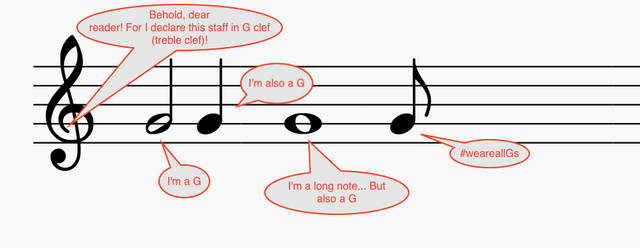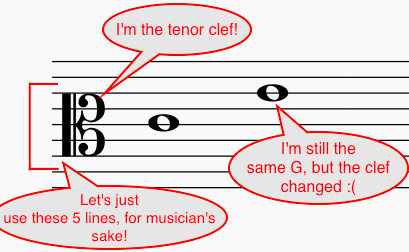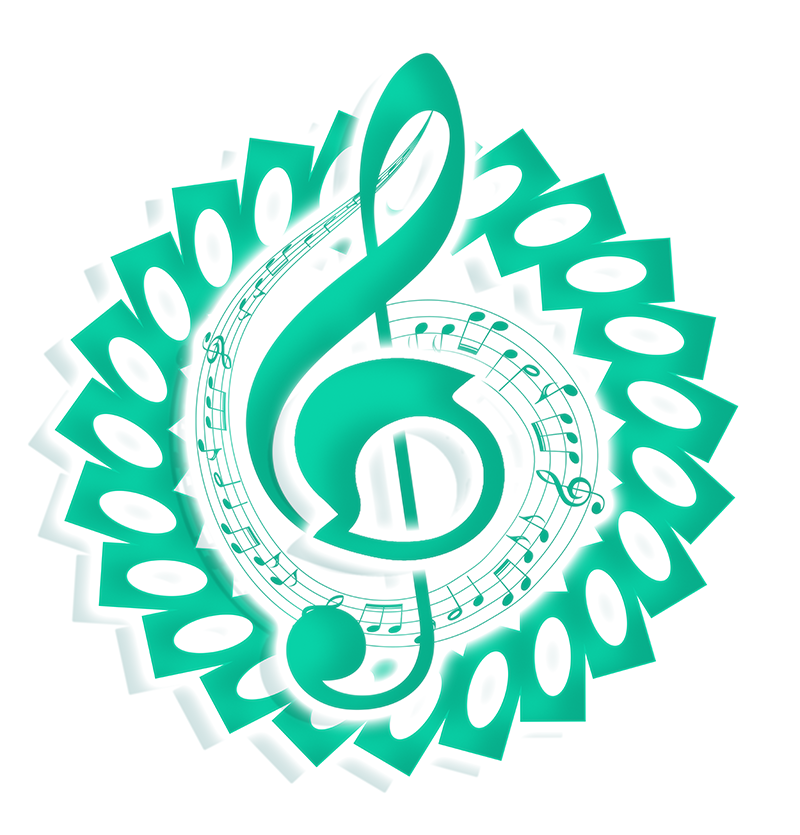You'll be reading music like a boss in no time! - Information Finding Championship - Season 1 : Round 19 entry
Easy peasy lemon squeezy
Contrary to the popular belief, those dots and lines in sheet music are very easy to understand, and have an intuitive basis once you get some easy concepts. In this post I'll drive you into those concepts starting with an historical interpretation of my own. And believe me, it's so easy that even you great-grand-mother would understand.
.jpg)
An Historical Context
In medieval ages, the average choir-boy would have to know something like 200 gregorian chants by memory (!!!), before they could even start singing in church events. If you ever heard gregorian chants you can imagine how big of an effort that was, since they're very very very similar: their musical value was as big as the elevation they would bring to the liturgy.
By writing the text and noting the variations in the melody just above it, they could help singers remember where the music was going, "Up" or "down" in pitch, just like you do in your voice when you sing. You're actually changing the frequency your vocal strings vibrate, passing that frequency to the air around.
During puberty, most men's voice starts changing and gets lower than most women's. That could be a reason for drawing a red line indicating where a specific pitch was. This was helpful so people could know how far from the "main" pitch they were and they wouldn't get lost so easily. An example:

Source
Now you know where I'm heading: this already seems like today's sheet music. If you can add one line to each pitch and starting notating duration, you could send the music over to anybody that could read it without even knowing it previously! There are examples of music notated in 4, 5, 6, 8 or 16 lines... Pretty confusing since you'd lose reference again. So people sticked with 4 or 5 lines as we use today.
.jpg)
Fast-forward to modern notation, the principle remains the same: "up" in the staff means "up" in your voice's pitch. Duration of the notes is based on length in the paper, "how much empty space you leave between notes", but for clearness we make notes white or black, with stems or without stems, depending on how much they should last. I'll go a bit further on rhythm and duration in another post.
Any staff starts with a clef. Clef comes from the latin clavis which means "key". It is pretty much a key: just like they used a red line to indicate a specific pitch, that's exactly what the clef makes. The treble clef indicates where the G (sol, in latin) is, meaning every thing that goes on that line is a G:

If that indicated G is a very high note (for example for some male voices) you'll end up using only the bottom lines, and constantly adding suplementary lines. And for the same reason, you'll likely not be using all those lines above G, right? So that's ok, you just add some lines to the bottom and eliminate some at the top. That way you keep using only 5 lines and it is still nice and tidy to read. Since the clef becomes a bit high on the paper, we change for another clef so the "reference" is still near the middle of the staff. For example, the tenor clef indicates where the C (do or ut) - 5 notes lower than the G - is:


So if ever you hear a musician complain about the clef changes, you can yell "HA-HA, the clef didn't change, you just started reading different lines!". But please don't do it, because things complicate A LOT along the way once you start octavating clefs and using transpositions... And you'll not want to hear a musician talk about it for hours.
That's pretty much all you need to know regarding note reading, assuming you already know the note's sequence (C-D-E-F-G-A-B-C-D-E... etc) and know that alternate between lines and spaces. Next "lesson" I'll talk about durations, rhythms, and hierarchy!
Pretty intuitive, right?
Did you know note reading was this easy?
Do you have any doubts? Just comment!

This is a double-entry for #educatorshowdown by @novili and Information Finding Championship. Go and upvote novili/follow him! and apolymask's post/blog!
If you enjoyed this post please consider:

Source: @runicar



This was interesting. The more I learn about language in general the more this kinda stuff resonates with me. Also the sol/G mean a whole different thing to me now with my occult eyes. I learned something new in regards to that. I also like the funny and light way you presented it. Good stuff! Thanks for the great entry.
Indeed! I also see a lot of similarities between language and music reading. Which makes sense, since language a huge inspiration (as it is dance! I'll talk about dance and rhythm in a later post). Sometimes the language even influenced the way music was written. I simplified here, but sure music writing was VERY different from place to place, since communication was limited
nice stuff.
Thank you! Stay tuned for more, about rhythm!
IFC musicology 101, between you and Benjy we may all be singing different tunes come July 18th. Nice post, useful, and fun to know stuff. I kind of knew a little bit about the g clef thingy on sheet music, and that sometime it was a different symbol, but I don't think I ever ran across that tenor one. So I learned. thanks
Great! Glad I could provide some information. There's also the bass clef that indicates the F below tenor's clef C. It's used by bass instruments such as double-bass, cello and bassoon :) The principle remains the same. But since these instruments usually play much higher notes as well, we're kind of used to change clefs for higher ones so it stays easy to read.
Thanks for the feedback, and stay tuned since I'll be posting about rhythm and that's cool stuff (I love it!)!
And @bengy is one of the most nice guys I met here in steemit :) his work with classical music radio and channels is great!
Awwwww thanks! By the way, do you mind changing one of the tags to classical-music so I can legitimately upvote with the radio curation trail?
Sure! I also just noticed I forgot the awesome banner at the bottom! I'll add both. Thank you!
On the discord, there is a cut and paste code, it will have the logo and details about the discord and community accounts.
Upvoted and resteemed!
The classical music community at #classical-music and Discord.
Follow our community accounts @classical-music and @classical-radio.
Follow our curation trail (classical-radio) at SteemAuto
Community Logo by ivan.atman
Thank you! :)
Congratulations! This post has been upvoted from the communal account, @minnowsupport, by zpedro from the Minnow Support Project. It's a witness project run by aggroed, ausbitbank, teamsteem, theprophet0, someguy123, neoxian, followbtcnews, and netuoso. The goal is to help Steemit grow by supporting Minnows. Please find us at the Peace, Abundance, and Liberty Network (PALnet) Discord Channel. It's a completely public and open space to all members of the Steemit community who voluntarily choose to be there.
If you would like to delegate to the Minnow Support Project you can do so by clicking on the following links: 50SP, 100SP, 250SP, 500SP, 1000SP, 5000SP.
Be sure to leave at least 50SP undelegated on your account.
Awesome entry @zpedro! I love learning the history of how thing come about. Thank you for including that in your entry! Good luck!!